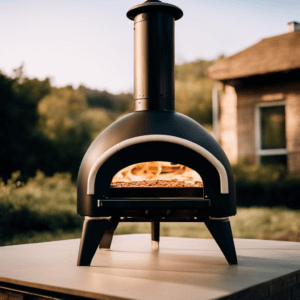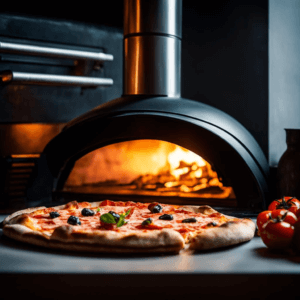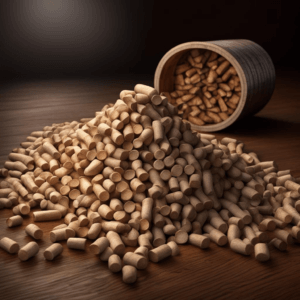Have you ever eagerly prepped a homemade pizza, and carefully placed it on your pizza stone, only to find it stuck like glue when you tried to remove it? You might have heard about using parchment paper as a solution to prevent sticking, but is it safe to use on a pizza stone?
Let’s delve into this common dilemma and explore whether parchment paper is a viable option for ensuring a hassle-free pizza-making experience.
Can You Use Parchment Paper on a Pizza Stone?
In short, avoid doing it because it’s not safe! Sprinkle your pizza stone with semolina instead.
The heat from a pizza oven is higher than from a standard oven.
So the parchment can burn and add a bad flavor to your pizza.
It can even cause a fire if you’re not careful.
However, some people have had success experimenting with using parchment paper on a pizza stone.
If you’re still set on using it, there are a few things to consider to ensure both safety and a deliciously crispy pizza.
1. Understand the Heat Tolerance:
Most parchment paper can’t withstand the high temperatures needed for optimal pizza baking on a stone.
Pizza stones need to be heated to around 500°F to achieve that perfect crispness.
And parchment paper usually maxes out around 430°F.
This temperature difference can make paper burn.
And this can affect the pizza’s texture, or even worse, cause a fire hazard.
2. Safety First:
Although some folks have had success using parchment paper on their pizza stones to prevent sticking, it’s always wise to err on the side of caution.
I’ve seen firsthand the consequences of pushing the limits with parchment paper in high-heat situations, and trust me, it’s not worth the risk.
3. Trim to Fit:
If you do decide to go ahead and use parchment paper, be sure to trim it to fit the size of your pizza.
So any overhanging edges won’t come into contact with the heating elements of your oven and won’t burn
4. Pizza Quality Issues:
While parchment paper can indeed prevent sticking, it tends to brown and even char around the edges ruining your pizza’s look and taste.
Plus, this extra layer between the dough and the pizza stone makes the crust less crispy.
So, to recap, while it’s technically possible to use parchment paper on a pizza stone, don’t do it for safety and quality reasons.
Instead, use alternative methods such as sprinkling your pizza stone with cornmeal or semolina.
This will prevent sticking while still creating that perfectly crisp crust.
What is a Pizza Stone?
A pizza stone is a special cooking surface for your oven that’s perfect for baking homemade pizzas.
It’s usually made from natural stone or ceramic.
You can place it inside your oven or pizza oven to help you cook up delicious pies.
How It Works:
When you put it in the oven and heat it, the stone absorbs that heat and spreads it out evenly across its surface.
This even heat distribution is crucial for cooking your pizza uniformly, with a crispy crust and perfectly melted toppings.
Why should you use a pizza stone?
Even heat from the pizza stone is perfect for avoiding those dreaded hot spots and making your pizza cook through evenly.
Plus, the stone helps draw moisture away from the dough as it bakes.
This produces a crust that’s crispy on the outside and chewy on the inside.
And here’s the best part – it’s not just for pizza!
You can use it to bake bread, pastries, or even reheat leftovers.
A pizza stone is a great investment as a versatile baking surface for your oven.
Tips for Using a Pizza Stone:
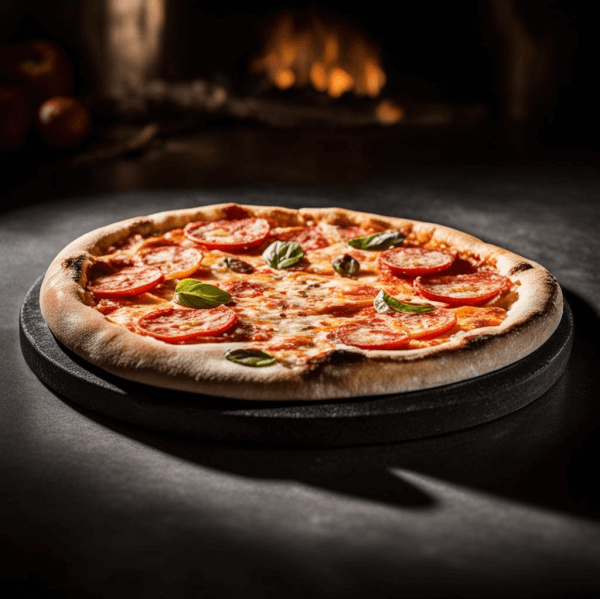
Ready to put your pizza stone to work?
Here are a few tips to help you get the most out of it.
- Always preheat your stone along with your oven. This ensures that it’s nice and hot when you slide your pizza onto it, which helps prevent sticking and creates an evenly cooked crust.
- Before you place your pizza dough on the stone, sprinkle a bit of cornmeal or semolina on the surface. This prevents sticking and adds a bit of extra flavor and texture to your crust.
- When you need to clean your pizza stone, keep it simple. Just scrape off any food residue and give the surface a wipe with a damp cloth. Avoid using soap or water, as they can get absorbed into the stone and affect the flavor and crispiness of your future pizzas.
What’s Parchment Paper?
Parchment paper is a great kitchen material that plays a big role in making cooking and baking easier.
It’s a type of paper that’s been treated with a special coating, usually silicone, to make it heat-resistant and non-stick.
This means you can use it in the oven without worrying about it burning (in normal baking temperatures, below 430°F) or sticking to your food.
What’s Parchment Paper Used For?
Parchment paper is incredibly versatile and has a bunch of different uses in the kitchen.
Here are some of the main ones:
1. Baking:
When you’re baking cookies, pastries, or pies in the oven, parchment paper is your best friend.
You can line baking sheets and pans with it to prevent your goodies from sticking, which also makes cleanup a breeze.
2. Roasting:
Ever roasted veggies or meats in the oven and struggled to clean the pan afterward?
Parchment paper to the rescue!
It helps prevent your food from sticking to the pan, making cleanup a whole lot easier.
3. Steaming:
If you’re into healthy cooking, parchment paper is ideal for steaming.
You can use it to create little packets for steaming fish or veggies.
Just wrap them up, seal the edges, and pop them in the oven or steamer.
4. Wrapping:
Have you ever heard of cooking “en papillote”?
It’s a fancy French technique where you cook food in parchment paper packets.
This method helps seal in moisture and flavor, resulting in super-tasty dishes.
5. Decorating:
Parchment paper isn’t just for cooking – it’s great for decorating too!
You can use it as a makeshift piping bag for icing cakes and pastries.
Just roll it into a cone shape, fill it with icing, and get creative with your designs.
Overall, parchment paper is like a superhero in the kitchen – it helps make cooking and baking easier, cleaner, and more fun.
Once you start using it, you’ll wonder how you ever cooked without it!
Risks of using parchment paper on a pizza stone
1. Fire Hazard:
Using parchment paper on a pizza stone can be risky because this material isn’t designed to withstand the high temperatures a pizza stone reaches.
If the paper gets too hot, it can catch fire, which is a big safety concern in the kitchen.
2. Reduced Crispiness:
Part of the magic of using a pizza stone is that it helps give your pizza that perfect crispy crust.
But when you put parchment paper between the dough and the stone, it can mess with that.
The paper acts as a barrier, which means the crust might not get as crispy as it would if it were directly on the stone.
3. Limited Heat Transfer:
Another downside of using parchment paper is that it’s not as good at conducting heat as the stone itself.
So, when you put parchment paper on top of a pizza stone, it kind of gets in the way of the heat transferring to the dough.
This can result in uneven cooking, with some parts of the crust ending up undercooked.
4. Difficulty in Removing Paper:
Once your pizza is done cooking, getting the parchment paper out from under it can be a bit tricky.
The paper tends to stick to the bottom of the pizza, so you have to be careful when peeling it off to avoid tearing the crust or leaving bits of paper behind.
5. Potential Flavor Transfer:
Some parchment papers are coated with things like silicone, which can give off weird flavors when they’re exposed to high heat.
If the paper burns or chars, it can also make your pizza taste funny. Nobody wants that!
6. Risk of Paper Burning:
If the parchment paper extends beyond the edges of the pizza and touches the oven’s heating elements, it can burn pretty quickly.
Not only does this affect the taste of your pizza, but it can also set off smoke alarms or even cause a fire if you’re not careful.
7. Risk of Damaging the Stone:
Continuously using parchment paper on a pizza stone can harm the stone itself over time.
Here’s how:
The combination of high heat from the oven and the presence of parchment paper can gradually wear down the stone.
This can lead to cracks, warping, or other damage to the structure of its surface.
Not only does this affect how well the pizza stone works, but it can also become a safety concern if the damage is severe enough.
In summary, while using parchment paper on a pizza stone might seem like a good idea at first, it comes with some serious risks that can affect the taste, texture, and safety of your pizza.
It’s something to think about before you give it a try.
Alternatives to using parchment paper on a pizza stone
1. Cornmeal or Semolina:
Sprinkling cornmeal or semolina directly onto the pizza stone before placing the dough on top is a classic trick.
These ingredients act as a natural non-stick barrier and absorb moisture from the dough, helping to prevent sticking and creating a crispy crust.
2. Flour:
Similar to cornmeal or semolina, dusting the pizza stone with flour can also create a non-stick surface.
However, it’s important not to overdo it, as too much flour can burn and affect the taste of the crust.
3. Olive Oil:
Brushing or drizzling a thin layer of olive oil onto the pizza stone before adding the dough can enhance the flavor of the crust and prevent sticking.
Also, be cautious not to overdo it. Excessive oil can cause smoke or even flare-ups in the oven.
Be sure to use a light hand to avoid making the crust greasy.
4. Preheating the Stone:
Giving the pizza stone plenty of time to preheat before adding the pizza dough can help prevent sticking.
A properly preheated stone creates a sear on the bottom of the crust, making it easier to release from the stone once it’s baked.
How to use parchment paper on a pizza stone safely
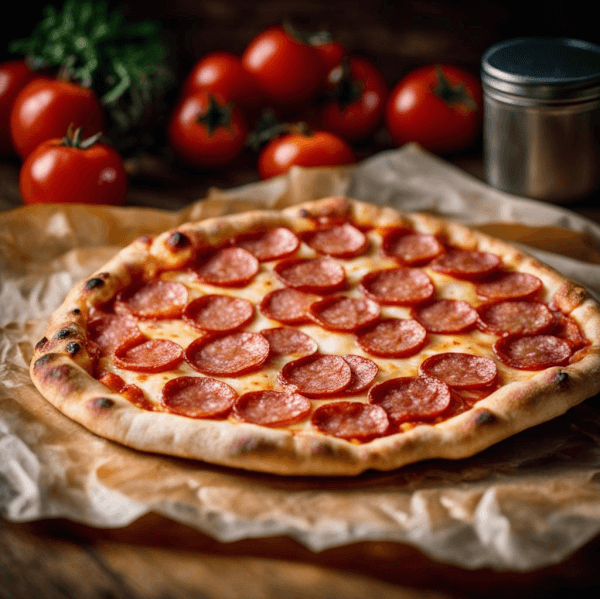
If you’re still set on using parchment paper with your pizza stone despite all the risks, here’s how to do it as safely as possible:
1. Trim to Fit:
Make sure to cut parchment paper to match the size of your pizza perfectly.
Avoid leaving any excess paper extending over the edges or hanging from the pizza stone, as it could come into contact with the oven’s heating elements and potentially catch fire.
2. Preheat the Stone:
Before baking, preheat your pizza stone in the oven along with the paper.
This will make sure that both the stone and the parchment are evenly heated, reducing the risk of any sudden temperature changes that could cause the paper to burn.
3. Keep an Eye Out:
Throughout the baking process, keep a close watch on the parchment paper.
If you notice any signs of burning, such as smoke or discoloration, act quickly!
Remove the pizza from the oven and carefully pull away the parchment paper to prevent any further damage.
4. Adjust the Temperature:
Consider lowering the oven temperature slightly when using parchment paper on a pizza stone.
This can help reduce the risk of the paper reaching its maximum heat tolerance and igniting.
5. Rotate the Pizza:
To ensure even cooking, rotate the pizza halfway through the baking time.
This helps to prevent any one area of the parchment paper from becoming too hot and potentially catching fire.
6. Handle with Care:
After baking, handle the pizza and parchment paper with caution.
They may be hot, so use oven mitts or kitchen towels to protect your hands.
Carefully transfer the pizza to a heat-safe surface and remove the parchment paper gently to avoid tearing.
7. Stay Alert:
Always stay vigilant when using parchment paper on a pizza stone.
If you notice any signs of smoke, burning, or other safety concerns, don’t hesitate to remove the pizza from the oven immediately.
Safety should always come first!
Can I use any type of parchment paper with my pizza stone?
It’s best to use parchment paper specifically labeled as food-safe, oven-safe, or heat-resistant.
Regular parchment paper may not be able to withstand the high temperatures of a pizza stone and could pose a fire hazard.
Can I reuse parchment paper?
Don’t reuse parchment paper, especially if it has been exposed to high temperatures or has become discolored or brittle.
Get a fresh piece for each baking session to be safe.
What should I do if the parchment paper sticks to the pizza crust after baking?
Carefully peel it away from the crust using a spatula or tongs.
If any bits of paper remain stuck to the crust, gently remove them with a clean, dry towel or brush.
How do I clean my pizza stone after using parchment paper?
Allow it to cool completely, then gently wipe away any residue with a damp cloth or sponge.
Avoid using soap or harsh chemicals, as they can affect the taste of future pizzas.
If the paper leaves behind stubborn bits, you can scrape them off with a spatula or brush.
Is a silicone baking mat a good alternative to parchment paper on a pizza stone?
No. Even though silicone baking mats are heat-resistant, they may not handle the high temperature needed for baking pizza. Their usual heat tolerance is below 500°F.
Plus, the mat will act as a barrier between the dough and the stone, and this won’t let the crispy crust form.
Can I just bake directly on a pizza stone without any liner or alternative to parchment paper?
Absolutely! Baking directly on a pizza stone is the best and most correct method for achieving a crispy crust.
Just make sure to preheat the stone thoroughly and lightly dust it with semolina to prevent sticking.
Final thoughts
Now that you know the potential risks of using parchment paper on a pizza stone, it’s best to avoid it and find alternative methods to prevent sticking.
Sprinkling semolina on the stone is a safe and effective option that will still give you a crispy crust without compromising your safety.







